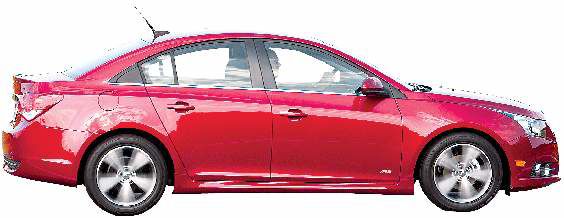With the Cruze, GM enters the race for small-car dollars
Published 5:00 am Sunday, August 15, 2010

- The 2011 Cruze is arguably the first small Chevrolet in 20 years that GM designed to be better than the competition.
Leadership inherently is at odds with the notion of “good enough.” Leadership believes it can do better. It works to become the best. “Good enough” makes peace with mediocrity and settles comfortably into oblivion, which is where General Motors has been for the past two decades in the small-car segment of the U.S. automobile market.
The company made passable small cars — the Chevrolet Cavalier, Chevrolet Cobalt, Chevrolet Aveo. Those models had four wheels, engines and steering wheels — and better fuel economy than GM’s trucks. They met federal crash-safety standards. They worked.
But GM’s little rides competed in a field of small cars made by companies that took small cars seriously: Honda, Toyota, Nissan, Hyundai, Kia. Those companies have always understood the power and value of “face” — giving respect by giving the best to those who could afford the least, giving them little cars they could be proud of, even love. They kicked GM’s small-car tail.
Now, there is solid evidence that GM is fighting back. It is the 2011 Chevrolet Cruze, arguably the first small Chevy in 20 years that GM designed to be better than the competition. It has better fuel economy than its rivals, better utility than most of them, and it is put together as well as all of them. It looks much richer than its base purchase price, which means it does an excellent job of saving face.
The Cruze is a compact, front-wheel-drive family car of which there are four iterations: base LS, midgrade 1LT and 2LT and top-grade LTZ. The LS is distinguished from its siblings with a normally aspirated (no forced air) 1.8-liter, inline four-cylinder engine (136 horsepower, 123 foot-pounds of torque).
The rest of the Cruze line is equipped with a turbocharged (forced air) 1.4-liter, inline four-cylinder engine (138 horsepower, 148 foot-pounds of torque).
An aside: Internal combustion engines require air and fuel to work. Generally, the more air and fuel an engine can handle, the more work it can do. But larger-volume engines, which can swallow more air and fuel, generally have poor fuel economy. Turbocharging, using exhaust-driven impellers to draw more fresh air into engine combustion chambers, is one way to increase power in smaller engines without an appreciable rise in fuel consumption.
I spent most of my time in the turbocharged 1.4-liter LTZ, equipped with a six-speed automatic transmission that also could be operated manually. What first caught my attention was the quality of the interior.
GM worked on and thought about the Cruze’s interior, which is unusual for the automaker. Fit and finish were excellent. Most materials, except a few plastic cover pieces at window corners, were first-class. A rust-and-black color scheme, with leather and simulated alloy trim on the dash and optional leather-covered seats, added to the cabin’s attractiveness.
Such touches increase the appeal of small cars and the willingness of consumers to buy them. But road performance is the grabber, and the Cruze LS and LTZ do a good job, although the LTZ model does it better.
There is none of the performance anemia in the Cruze often found in the Cavalier and Cobalt (excluding the quite likable Cobalt SS model). The 1.8-liter and 1.4-liter four-cylinder engines performed smoothly. The LTZ’s turbocharged 1.4-liter engine brought smiles to my face.
I ended my daylong run in the Cruze cars confident that I was right to continue believing in GM’s people when it seemed everyone else had turned against them. They have the right stuff. They simply needed corporate leaders to pull it out of them.
The bottom line
The Chevrolet Cruze is a bona fide contender for your small-car dollar. You would be making a serious mistake if you did not put it on the same shopping list as the Ford Focus, Honda Civic, Hyundai Elantra, Kia Forte and Toyota Corolla.
Ride, acceleration and handling: The Cruze LS gets an excellent mark for small-car ride and good marks for acceleration and handling. The more spirited and likable LTZ gets excellent marks all around.
Head-turning quotient: The Cruze looks richer than it is, inside and out. Congratulations to GM and Chevrolet for finally comprehending the difference between “economy” and “tacky.” One honors the low-cost buyer. The other disparages that customer.
Capacities: There are seats for five people in the Chevrolet Cruze. Maximum luggage space is 15.4 cubic feet. The Cruze holds 15.6 gallons off gasoline.
Safety: Standard equipment includes front and rear ventilated disc brakes, four-wheel antilock brake protection, electronic brake force monitoring and distribution, electronic stability and traction control, side and head air bags, dual front knee air bags, and tire pressure monitoring.
2011 Chevrolet Cruze
Base price: $16,275 (Cruze LS); $21,975 (Cruze LTZ)
As tested: $15,624 (Cruze LS); $21,096 (Cruze LTZ)
Type: The Chevrolet Cruze is a compact, front-engine, front-wheel-drive, four-door economy car with a traditional notchback trunk. It is available in four iterations: base LS, midgrade 1LT and 2LT and top-grade LTZ.
Engine: There are two available engines including a normally aspirated 1.8-liter, 16-valve, inline four-cylinder model (136 horsepower, 123 foot-pounds of torque) linked to a six-speed manual transmission; and a turbocharged 1.4-liter, 16-valve, inline four-cylinder engine (138 horsepower, 148 foot-pounds of torque) linked to an automatic six-speed transmission that can be operated manually.
Mileage: Unlike most cars with turbocharged engines, this one takes regular fuel. Our real-world estimate for the Cruze LTZ was 40 miles per gallon on the highway. City driving was minimal.






